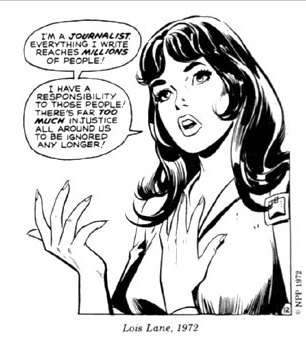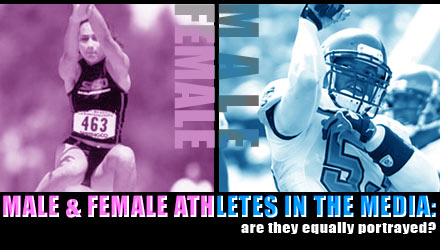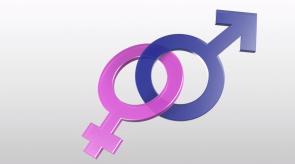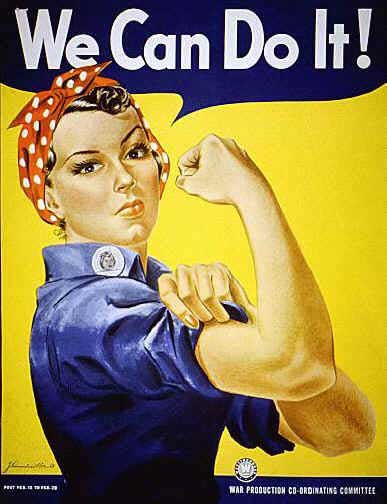 Image obtained: http://blogs.setonhill.edu/LeslieRodriguez/030905.html
Image obtained: http://blogs.setonhill.edu/LeslieRodriguez/030905.html
This backgrounder examines the status and underrepresentation of female journalists.
The media influences the world and the way their audience views it. Journalists are powerful individuals who research and gather information that eventually gets shared with many; society calls this information news. Those providing the news are important. Equal representation of both male and female journalists in the media is important because equality is a right. An audience can grow if the representation is equally distributed because interest from this audience will arise. Male and female representation within the media has been a hot topic for quite some time now and is a topic that should be further looked into.
History, Females and Journalism
Journalists have been our "go to" voices for information. When there is something we want to know, we look to the news and those gathering the information to provide us with the story and its facts. Journalists have a profound impact in the way the public obtains information and how they learn.
Since 1608 when the first newspaper surfaced through the works of Captain John Smith titled Newes from Virgina, the world of journalism has transformed the way people find things out. The journalistic world has advances since then providing multiple ways and mediums to help provide news to a broad audience.
The female role in journalism has come a long since it first originated. Females had no place in the media in its early stages. The struggle for unified and equal representation of male and female journalists was very much present in the media. Women had no place and no voice inside the newsroom, nor did they have any say in what was newsworthy. As journalism began to be a profession, females were restricted and discriminated. That notion began to change when a group of female pioneer journalists began to fight for the rights of female journalist.
A female pioneer, Nellie Bly, transformed the journalistic world. Bly was hired at a young age to write for the Pittsburg Dispatch but had to use a pseudonym because it was forbidden for women to be journalists. However, Bly took this opportunity to argue for the reform of marriage and divorce laws. Her voice was very important not only for the female journalist, but for the female in general.
If you look at newsrooms today, there is a pretty strong female representation taking place. Females are working in the media and are beginning to dominate the work force; however, it is still a work in progress.
Image obtained: http://learnsomethingnewtoday.us/2008/04/20/significant-firsts-for-women-in-us-politics/
Current Situation
If we look at today's newsroom, there is most certainly an array of female representation. Male representation in the media is still higher than the representation of females. It must be understood that there is no proof or vendetta against the female journalist being underrepresented; however, it is obvious to the eye that the process of becoming and being a journalist is more of struggle for the female versus the male. Jennie Ruby explains in her article "Women in Media" that an overall 35% of "behind the news" workers in radio, print and television combined are female journalists leaving the remaining 65% to males. This difference is quite significant and puts forth the reason why gender and media topics are being discussed within today's societies. Using this statement put forth in Ruby's article to categorize every institution as underrepresenting females within the media is unfair because progress has been made. The real issue is how much. If we were to look at CTV Montreal as an example of a media institution, the positions are more or less equally shared between both sexes. You will see just as much female representation as you will male. The difference could lie in who is saying what. The female is hardly ever seen as the sports broadcaster and a lot of the times the head news anchor is male. But to say that every media institution is promoting the male journalists and demoting the female journalist is something that has to be carefully looked into before being stated. However, there is a gap that is still present within certain sections of the media and that is what is of most importance when analyzing gender and journalism.
Looking at topic selection or those selected as specialists, the viewer can at times see less female representation within this section as well. If focusing on female athletes as a subject, there will generally be less representation of them in comparison to male athletes. In Jennie Ruby's article, readers are equally provided with percentiles that show the average male versus female coverage in the media; 5% of the time female athletes are the main focus of a journalistic article, while 35% of the time is male". The remaining 60% could be general updates or highlights from events. Demonstrating both the interviewer and subject topic, it can be understood that the female is still finding its way in the media.
 Image obtained: http://www.bodybuilding.com/fun/drobson42.htm
Image obtained: http://www.bodybuilding.com/fun/drobson42.htm
Female Journalists and the Future
Stereotypes are still present within the media in regards to females. Some individuals still to this day view the idea of a female being the voice of information negatively. In their article " 'Feeling Much Smaller than You Know You Are': The Fragmented Professional Identity of Female Journalists", Marie Hardin and Stacie Shain provide insight on the stereotype of female journalists. They explain:
"Adopting a masculine (''objective,'' detached) approach to journalism presents its own risks, as women are expected not to become assertive. Ferguson (1990) points out the widespread understanding that ''competent women are seen (by both sexes) as being pushy, choosy, mouthy and having slept their way to the top'' (p. 220). Further, female journalists who seek to improve perceptions and positions of women are likely to be seen as deviant (van Zoonen, 1994), and thus undesirable inside newsrooms."
 Image obtained: http://blogs.worldbank.org/developmenttalk/gender-equality-and-the-2012-world-development-report
Image obtained: http://blogs.worldbank.org/developmenttalk/gender-equality-and-the-2012-world-development-report
The world of media is still adapting to the norms of society were equal rights are present. It must be understood that female position within the media has progressed from its early stages and do have a stronger role. Females have more of a voice than they once did, and the division between both sexes is much smaller than it once was. It can equally be stated that both sexes are almost at an equal within the newsroom. To say that both male and female representation in the media is equally shared, is something that still needs to be investigated. The improvement is there for us to see, but how much has been improved and were these improvements have taken place is what really needs to be examined.
Documentation
Shifflett, Bethany, and Rhonda Revelle. "Gender Equity In Sports Media Coverage: A Review Of The Ncaa News." Journal Of Sport & Social Issues 18.2 (1994): 144-150. Academic Search Complete. Web. 15 Sept. 2012.
Hardin, Marie, and Stacie Shain. "Feeling Much Smaller Than You Know You Are": The Fragmented Professional Identity Of Female Sports Journalists." Critical Studies In Media Communication 23.4 (2006): 322-338. Academic Search Complete. Web. 15 Sept. 2012.
Ordman, Virginia L., and Dolf Zillmann. "Women Sports Reporters: Have They Caught Up?." Journal Of Sport & Social Issues 18.1 (1994): 66-75. Academic Search Complete. Web. 15 Sept. 2012.
Warren Whisenant, et al. "The Current State Of Women Print Journalists: An Analysis Of The Status And Careers Of Females In Newspapers Sports Departments." Public Organization Review 5.3 (2005): 219-232. Academic Search Complete. Web. 15 Sept. 2012.
Hardin, Marie, and Stacie Shain. "Feeling Much Smaller Than You Know You Are": The Fragmented Professional Identity Of Female Sports Journalists." Critical Studies In Media Communication 23.4 (2006): 322-338. Academic Search Complete. Web. 15 Sept. 2012.
Beam, Randal A., and Damon T. Di Cicco. "When Women Run The Newsroom: Management Change, Gender, And The News." Journalism & Mass Communication Quarterly 87.2 (2010): 393-411. Academic Search Complete. Web. 15 Sept. 2012.
Ruby, Jennie. "Women In Media." Off Our Backs 37.1 (2007): 14-17. Academic Search Complete. Web. 15 Sept. 2012.
Valdez20832. "Women in Sports Broadcasting: Crossing Gendered Lines." (2008). YouTube. 15 Sept. 2012.
Tsui, Celia Y. S., and Francis L. F. Lee. "Trajectories Of Women Journalists' Careers In Hong Kong." Journalism Studies 13.3 (2012): 370-385. Academic Search Complete. Web. 15 Sept. 2012.
Clavio, Galen, and Andrea N. Eagleman. "Gender And Sexually Suggestive Images In Sports Blogs." Journal Of Sport Management 25.4 (2011): 295-304. Academic Search Complete. Web. 15 Sept. 2012.

Leave a comment